I would like to thank guest reviewer Jim Flemming for bringing us this review of Cinque Terre.
Cinque Terre is a recent release from Rio Grande Games and designer Chris Handy (the designer of Long Shot). In the game, players are farmers, harvesting crops and selling produce to the five coastal villages in the Liguria region of Italy, or, the Cinque Terre. Players are represented by very nice wooden truck pieces that move around the 8 spaces of the colorful board. The goal of the game is to be the player who has gained the most money (VP) by game end. Pursuing this goal is relatively simple, as each turn, players have 3 actions to perform and 4 possibilities to choose from. Players can either move their truck up to 4 spaces, draw a card, harvest crops from a farm space, or sell produce to a village space.
The spaces of the board are laid out in a circle, with the 5 villages in a row, and the 3 farm spaces in a row between the first and last village. Players can move their truck up to 4 spaces in a clockwise direction.
Produce cards are laid out � la Ticket to Ride, with 4 face up and the rest face down in a deck. Players can either draw a face up card, which is immediately replaced, or the top card of the deck.
The fourth action a player can take is to sell produce to a village. If a player�s truck is in a village space, she can sell any number of produce cubes from her truck to the village. When selling produce, the player puts any cubes sold on her player board in the row of the village she sold to. She immediately receives Lira (VP) on the score track equal to the demand for the produce she sold. Some villages will value certain produce more than others. This is represented by the colored dice next to each village.
Players place produce cubes they have sold on their player boards in order to keep track of what produce they have sold to each village. Additionally, if a player is the first to sell 8 produce to any village, she will score bonus points as that village�s Most Popular Vendor. She will collect that village�s MPV tile, and score as many Lira as is pictured.
Players will be able to get a good number of points from simply delivering produce that is highly valued by certain villages, however there is a much better way to score Lira in Cinque Terre.
A number of order cards equal to the number of players will be laid face up next to the board. These can be claimed by any player at the end of her turn, if she has fulfilled the requirements. So, for example, if after taking her three actions, Rachael has delivered at least 1 orange to Monterosso and 1 lemon to Riomaggiore, she can claim the shown card for 8 points.
The game ends when 1 player has collected 5 public order cards in front of herself, all of the Most Popular Vendor tiles have been taken, or if two types of crops have been completely taken from their fields. Players then score all of their private order cards. Any private orders they are not able to fulfill score negative 5 Lira for every piece of produce they are missing. The player with the most Lira wins!
Pros: Cinque Terre has a lot going for it. First, the components and the art are beautiful. I really enjoy how vibrant the colors are. The quality of the components is also very high. The cardstock used is one of my favorites - high quality, thick, and very easy to read. The wooden trucks are great as well, though they would�ve been nicer if they were more capable of holding four cubes in their beds (as they are, the cubes often fall out) - not a big deal, but it would�ve made a great component excellent.
The presence of the public order cards really adds a fantastic level of tension to the game. After claiming a public order card, a player then has an interesting choice. She draws and looks at the top card of the order deck, then decides whether she wants to keep it as a private order card which will score at the end of the game, or use it to replace the order card she took at the end of her turn. THEN, she can either choose to draw the next order card and be forced to keep it, or simply not draw.
In traditional Euro fashion, there is no way to directly attack your opponents, but a player who is able to be more efficient with her actions (and who may get a bit luckier with card draw) will have opportunities to grab order cards out from under her opponents, and really screwing them.
I also really like the dynamic scoring balance that Mr. Handy has established here. Players are able to score big by going for the order cards. But players could also concentrate on simply delivering high valued produce to the same villages over and over again, attempting to get some MPV tiles and end the game before the other players can fulfill enough orders to win.
Cons: Like any game with cards, there may be a few game sessions where one or two players have really good or poor luck when drawing their cards. The problem is that while drawing the wrong crop card is mitigated (two matching crops can be used as one of any crop), drawing the right crop card is much more efficient. Another place this comes into play is when players draw new order cards. A player could, especially later in the game, draw an order card that she already has completed. These lucky situations are inevitable and what make the game worth playing more than once.
A comparison between Cinque Terre and Ticket to Ride is easy to make. They both use the same card drawing mechanism and both allow players to score during play but also reward players for fulfilling prescribed conditions (tickets/orders). I think that both games are wonderful, but I think that Cinque Terre makes a much better candidate for �gateway game.� Ticket to Ride is fun, and easy to explain, but I�ve thought for a long time that it does not introduce very many new concepts to a player who has not played many �modern� board games. To me, TtR is rummy with a board. Cinque Terre, on the other hand, not only has set collection, but also pickup and deliver, (at least) two fairly distinct paths to victory, action points, public goals, and a dash of push your luck. There is something to be said for TtR�s stripped down approach, but shouldn�t a �gateway� game give new players not only a taste of something new, but also a �tutorial� of sorts on new concepts that are out there in the wide world of gaming? I think that Cinque Terre is simple enough for everyone to enjoy, but also complex enough to whet some players� appetites for more.
I would give Cinque Terre a solid 7.5. It is a lovely game whose beauty and simplicity belie the gorgeous depth and delicious cut-throatedness that lies in wait. It is being added to the very short list of games that I would both play with my wife or my gaming group and also feel confident about bringing to either of our parents� homes to play with them.
If Cinque Terre sounds fun, you might also check out Village, Pantheon, and Orbit Rocket Race 5000.
Board Game Reviews by Josh would like to thank Rio Grande Games for providing a review copy of Cinque Terre.
Cinque Terre is a recent release from Rio Grande Games and designer Chris Handy (the designer of Long Shot). In the game, players are farmers, harvesting crops and selling produce to the five coastal villages in the Liguria region of Italy, or, the Cinque Terre. Players are represented by very nice wooden truck pieces that move around the 8 spaces of the colorful board. The goal of the game is to be the player who has gained the most money (VP) by game end. Pursuing this goal is relatively simple, as each turn, players have 3 actions to perform and 4 possibilities to choose from. Players can either move their truck up to 4 spaces, draw a card, harvest crops from a farm space, or sell produce to a village space.
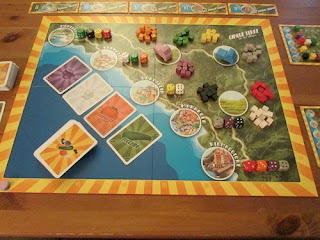 |
Set up for 2 players. |
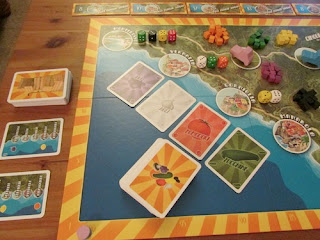 |
| The four cards in the top row as well as the top card of the face down deck are available to be drawn by players. |
Produce cards are laid out � la Ticket to Ride, with 4 face up and the rest face down in a deck. Players can either draw a face up card, which is immediately replaced, or the top card of the deck.
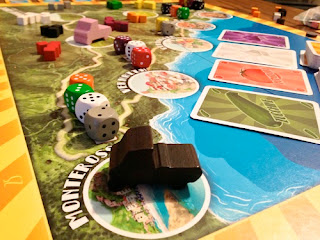 |
| Players would earn 5 Lira (VP) for selling garlic (white) to Monterosa, or 2 for selling mushrooms (grey). |
The fourth action a player can take is to sell produce to a village. If a player�s truck is in a village space, she can sell any number of produce cubes from her truck to the village. When selling produce, the player puts any cubes sold on her player board in the row of the village she sold to. She immediately receives Lira (VP) on the score track equal to the demand for the produce she sold. Some villages will value certain produce more than others. This is represented by the colored dice next to each village.
Players place produce cubes they have sold on their player boards in order to keep track of what produce they have sold to each village. Additionally, if a player is the first to sell 8 produce to any village, she will score bonus points as that village�s Most Popular Vendor. She will collect that village�s MPV tile, and score as many Lira as is pictured.
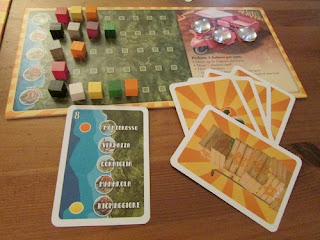 |
| If this player was the first to sell 8 produce to Monterosso or Corniglia, she would receive the MPV tiles for those villages. |
Players will be able to get a good number of points from simply delivering produce that is highly valued by certain villages, however there is a much better way to score Lira in Cinque Terre.
A number of order cards equal to the number of players will be laid face up next to the board. These can be claimed by any player at the end of her turn, if she has fulfilled the requirements. So, for example, if after taking her three actions, Rachael has delivered at least 1 orange to Monterosso and 1 lemon to Riomaggiore, she can claim the shown card for 8 points.
The game ends when 1 player has collected 5 public order cards in front of herself, all of the Most Popular Vendor tiles have been taken, or if two types of crops have been completely taken from their fields. Players then score all of their private order cards. Any private orders they are not able to fulfill score negative 5 Lira for every piece of produce they are missing. The player with the most Lira wins!
Pros: Cinque Terre has a lot going for it. First, the components and the art are beautiful. I really enjoy how vibrant the colors are. The quality of the components is also very high. The cardstock used is one of my favorites - high quality, thick, and very easy to read. The wooden trucks are great as well, though they would�ve been nicer if they were more capable of holding four cubes in their beds (as they are, the cubes often fall out) - not a big deal, but it would�ve made a great component excellent.
The presence of the public order cards really adds a fantastic level of tension to the game. After claiming a public order card, a player then has an interesting choice. She draws and looks at the top card of the order deck, then decides whether she wants to keep it as a private order card which will score at the end of the game, or use it to replace the order card she took at the end of her turn. THEN, she can either choose to draw the next order card and be forced to keep it, or simply not draw.
In traditional Euro fashion, there is no way to directly attack your opponents, but a player who is able to be more efficient with her actions (and who may get a bit luckier with card draw) will have opportunities to grab order cards out from under her opponents, and really screwing them.
I also really like the dynamic scoring balance that Mr. Handy has established here. Players are able to score big by going for the order cards. But players could also concentrate on simply delivering high valued produce to the same villages over and over again, attempting to get some MPV tiles and end the game before the other players can fulfill enough orders to win.
Cons: Like any game with cards, there may be a few game sessions where one or two players have really good or poor luck when drawing their cards. The problem is that while drawing the wrong crop card is mitigated (two matching crops can be used as one of any crop), drawing the right crop card is much more efficient. Another place this comes into play is when players draw new order cards. A player could, especially later in the game, draw an order card that she already has completed. These lucky situations are inevitable and what make the game worth playing more than once.
A comparison between Cinque Terre and Ticket to Ride is easy to make. They both use the same card drawing mechanism and both allow players to score during play but also reward players for fulfilling prescribed conditions (tickets/orders). I think that both games are wonderful, but I think that Cinque Terre makes a much better candidate for �gateway game.� Ticket to Ride is fun, and easy to explain, but I�ve thought for a long time that it does not introduce very many new concepts to a player who has not played many �modern� board games. To me, TtR is rummy with a board. Cinque Terre, on the other hand, not only has set collection, but also pickup and deliver, (at least) two fairly distinct paths to victory, action points, public goals, and a dash of push your luck. There is something to be said for TtR�s stripped down approach, but shouldn�t a �gateway� game give new players not only a taste of something new, but also a �tutorial� of sorts on new concepts that are out there in the wide world of gaming? I think that Cinque Terre is simple enough for everyone to enjoy, but also complex enough to whet some players� appetites for more.
I would give Cinque Terre a solid 7.5. It is a lovely game whose beauty and simplicity belie the gorgeous depth and delicious cut-throatedness that lies in wait. It is being added to the very short list of games that I would both play with my wife or my gaming group and also feel confident about bringing to either of our parents� homes to play with them.
If Cinque Terre sounds fun, you might also check out Village, Pantheon, and Orbit Rocket Race 5000.
Board Game Reviews by Josh would like to thank Rio Grande Games for providing a review copy of Cinque Terre.

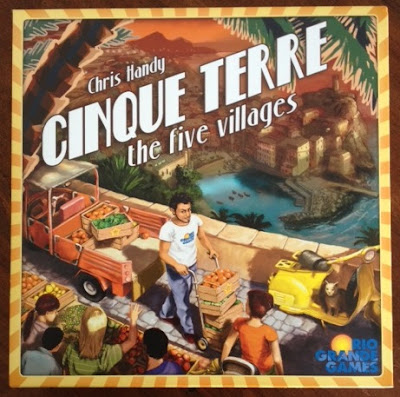
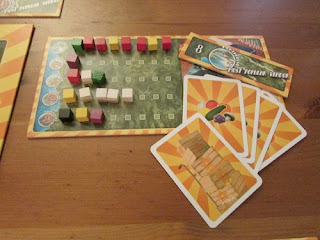

0 komentar:
Posting Komentar